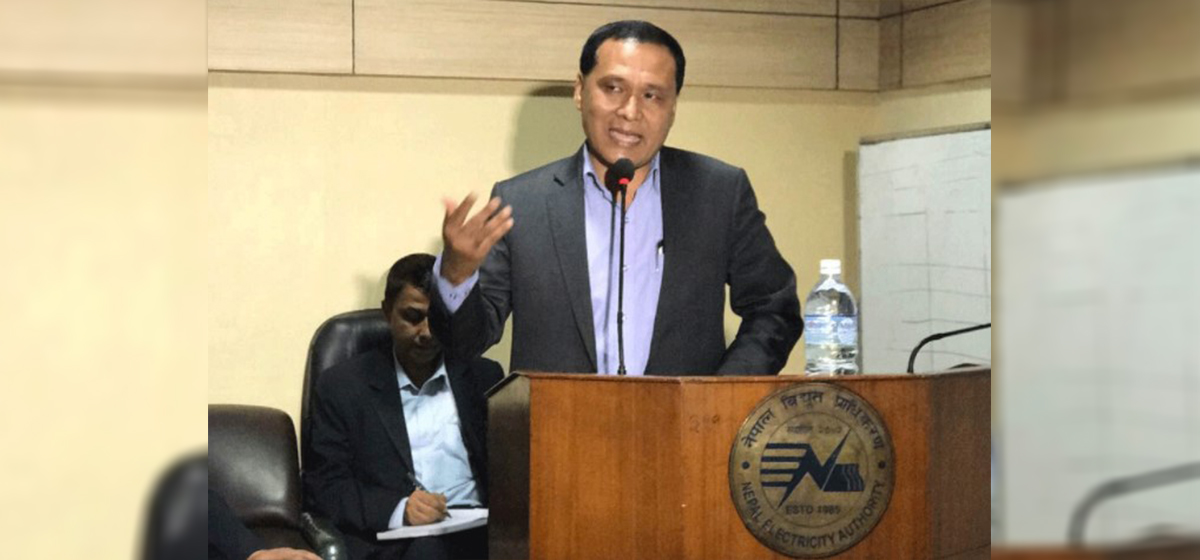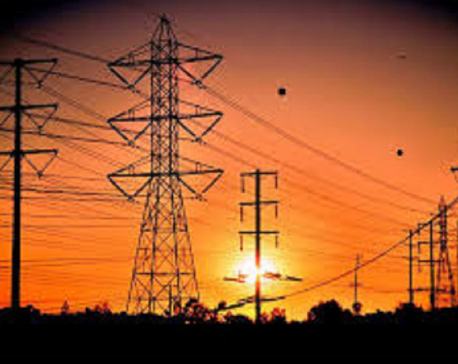
OR
MD Ghising: NEA to work on increasing domestic consumption and exporting surplus electricity
Published On: August 18, 2022 03:00 PM NPT By: Republica | @RepublicaNepal

KATHMANDU, August 18: Nepal Electricity Authority (NEA) has revealed that working on making the country self-reliant in hydropower and exporting surplus hydroelectricity to neighboring countries remained its long-term goals. Speaking at the NEA’s 37th Anniversary Program held on Wednesday, dignitaries attending the program including NEA’s Managing Director Kul Man Ghising shared the plans of the authority.
NEA, established on August 16, 1985, organized its 37th Anniversary Program on Wednesday, celebrating 37 years of its existence. Elucidating the achievements of the authority in the past years, Managing Director Ghising also disclosed that the authority, which has been producing more hydroelectricity than the current demand of the country, would be prioritizing the construction of necessary infrastructures for the distribution of electricity and management of the market to export surplus electricity to other countries in the future.
He added that the NEA is keen about cooperating with private as well as other public enterprises to develop large reservoir-based and semi-reservoir-based hydropower projects, for which, 635 MW Dudhkoshi, 1061 MW Upper Arun, 210 MW Chainpur Seti, 99 MW Tamakoshi-V, and 60 MW Modi (Upper and Lower) hydropower projects remain a high priority.
NEA collected its highest profit in the fiscal year 2021/22 with the net profit amounting to Rs 16.16 billion — about 4.6 times greater than that of the fiscal year 2020/21. Before Ghising was appointed NEA’s Managing Director, the authority had been under a huge financial loss, and the country experienced chronic load-shedding for about a decade. Not only is Ghising attributed for propelling the improvement of NEA’s financial health, but he is also credited with ending load-shedding in the country. Ghising, in his speech, mentioned that NEA currently had an ICRA rating of AA+.
Ghising said that with more hydropower projects advancing in the days ahead, the country would be producing more electricity than the demand. While he stressed the need for exporting surplus electricity, he also said that there is a need to increase electricity consumption within the country. For this, the NEA is going to run programs that help increase awareness amongst the people about the need to switch to electric stoves, electric vehicles, and other electric technologies.
He also went on to acknowledge the role of hydropower in replacing the consumption of petroleum products which constitute the biggest contributor to Nepal’s increasing trade deficit. In regard to this, he said that the authority would be working on building numerous charging ports in major cities and highways to encourage the use of electric cars and increase the ease of those who already use such cars.
Six years ago, only 62 percent of the population consumed electricity distributed from the national grid. Today the figure stands at 93 percent. Including alternative sources of electricity, today 96% of people in the country have access to electricity. In the past few years, the authority has been able to increase the accessibility to electricity, control electricity leakage, and increase hydroelectricity production in the country. Ghising highlighted the authority’s aim to extend accessibility to electricity to 100% of the population in the next two years. He also said that NEA is also to continue connecting capacitor banks in various distribution and grid substations to reduce electricity leakage.
Many speaking at the program complained about instances of deaths of workers during the construction of the projects, to which Ghising, in his speech, said that the authority will be addressing the issue and working to improve security in the workplace.
You May Like This

15,000 MW of hydroelectricity will be produced in next five years: Ghising
KATHMANDU, Nov 25: Nepal Electricity Authority (NEA) Managing Director Kulman Ghising has said that within the current financial year, Nepal's... Read More...

Nepal sales electricity worth Rs 10.39 billion to India in five and a half months
KATHMANDU, Nov 19: Nepal has earned an income of 10.39 billion rupees from electricity export. ... Read More...

NEA ED Ghising pledges quality power supply
KATHMANDU, Sept 14: Executive Director of Nepal Electricity Authority (NEA) Kulman Ghising has said that preparations are ongoing to ensure... Read More...




Just In
- Insurers stop settling insurance claims after they fail to get subsidies from government
- Nepal-Qatar Relations: Prioritize promoting interests of Nepali migrant workers
- Health ministry to conduct ‘search and vaccinate’ campaign on May 13
- Indian customs releases trucks carrying Nepali tea, halted across Kakarbhitta
- Silent period for by-election to begin from midnight
- SC issues short-term interim order to govt and TU not to take immediate action against TU legal advisor Khanal
- National consultation workshop advocates to scale up nutrition smart community in Nepal
- Patan High Court issues short-term interim order to halt selection process of NTB’s CEO













Leave A Comment